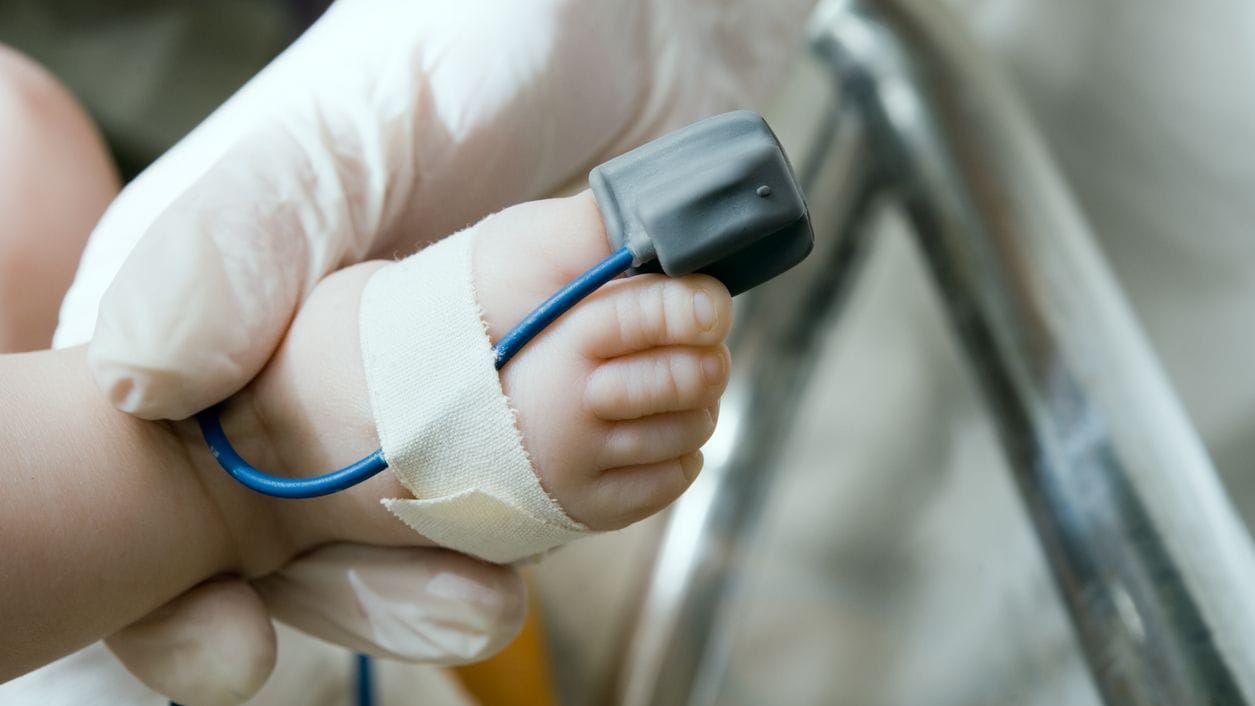Key points
- About 1 in 4 babies born with a heart defect has a critical congenital heart defect (critical CHD).
- Babies with a critical CHD need surgery or other procedures in the first year of life.
- Newborn screening using pulse oximetry can help identify a critical CHD, so babies can receive prompt care and treatment.

Importance of screening
Some babies with a critical CHD appear healthy at first and may be sent home before their critical CHD is detected. These babies are at risk of having serious complications early in life and often need emergency care.
Newborn screening for critical CHDs can help identify babies before they go home from the birth hospital. Diagnosing a critical CHD before a baby leaves the hospital helps the healthcare team:
- Provide prompt care and treatment, which may prevent disability or death early in life
- Better plan treatment, which can help the baby have surgery or other treatment when stable, not in an emergency situation
About 1 in 4 babies born with a heart defect has a critical CHD.1 As of 2018, all 50 states and Washington D.C. have newborn screening programs to test for critical CHDs.2
Screening for critical CHD reduces early infant deaths
When to get screened
Screening is done when a baby is at least 24 hours of age. If hospital discharge is planned before 24 hours of age, the baby should be screened as late as possible before discharge.
How screening works
Newborn screening for critical CHDs involves a simple bedside test called pulse oximetry. This test estimates the amount of oxygen in a baby's blood. Low levels of oxygen in the blood can be a sign of a critical CHD. The test is done using a machine called a pulse oximeter, with sensors placed on the baby's skin. The test is painless and takes only a few minutes.
Pulse oximetry screening does not replace a complete history and physical exam. Sometimes, a physical exam can detect a critical CHD before oxygen levels in the blood become low. Pulse oximetry screening, therefore, should be used along with the physical exam.

Screening results
Pulse oximetry screening is most likely to detect seven of the critical CHDs. Other heart defects can be just as severe as these seven and also require treatment soon after birth. However, pulse oximetry screening may not detect these heart defects as consistently as the seven listed below.
Seven critical CHDs most likely detected by screening
Pass
If a baby passes the screen, it might also be called a "negative" or "in-range" result. This means that the baby's results did not show signs of a low level of oxygen in the blood. A baby that passes the screen is unlikely to have a critical CHD.
Some babies with a critical CHD will not have a low level of oxygen in the blood detected during newborn screening. Thus, it is possible for a baby who passes the screen to still have a critical CHD or other CHD.
Fail
If a baby fails the screen, it might also be called a "positive" or "out-of-range" result. This means the baby's results showed low levels of oxygen in the blood. This could be a sign of a critical CHD.
A failed screen doesn't always mean a baby has a critical CHD, but it could mean that more testing is needed. Other health issues, such as breathing problems, can also lead to low levels of oxygen in the blood. The baby's doctor might recommend that the baby get screened again. Or they may suggest more specific tests, like an echocardiogram (an ultrasound picture of the heart), to diagnose a critical CHD.
- Oster M, Lee K, Honein M, Colarusso T, Shin M, Correa A. Temporal trends in survival for infants with critical congenital heart defects. Pediatrics. 2013;131(5):e1502-8.
- Glidewell J, Grosse SD, Riehle-Colarusso T, Pinto N, Hudson J, Daskalov R, Gaviglio A, Darby E, Singh S, Sontag M. State Actions in Support of Newborn Screening for Critical Congenital Heart Disease — United States, 2011–2018. MMWR Morb Mortal Wkly Rep. 2019; 68: 107–111.
- Abouk R, Grosse SD, Ailes EC, Oster ME. Association of US State Implementation of Newborn Screening Policies for Critical Congenital Heart Disease With Early Infant Cardiac Deaths. JAMA. 2017; 318(21): 2111-2118.
